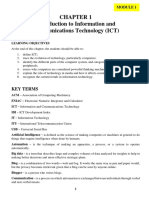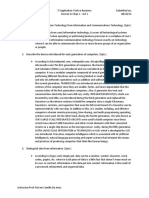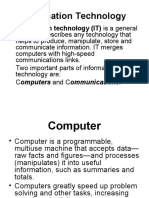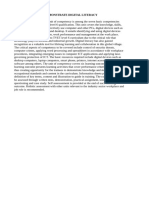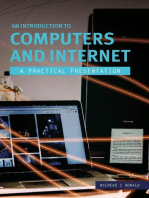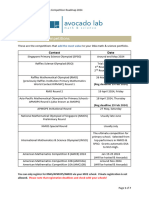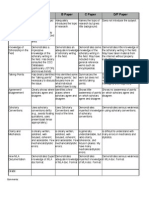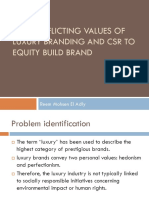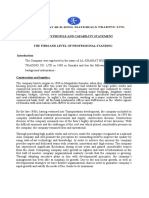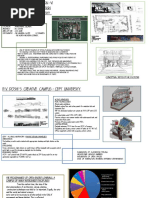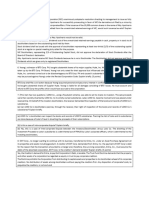0 ratings0% found this document useful (0 votes)
2 viewsBSIT 1A Activity (Answer)
BSIT 1A Activity (Answer)
Uploaded by
EllyActivity about the definitions of general terms in computing
Copyright:
© All Rights Reserved
Available Formats
Download as DOCX, PDF, TXT or read online from Scribd
BSIT 1A Activity (Answer)
BSIT 1A Activity (Answer)
Uploaded by
Elly0 ratings0% found this document useful (0 votes)
2 views3 pagesActivity about the definitions of general terms in computing
Copyright
© © All Rights Reserved
Available Formats
DOCX, PDF, TXT or read online from Scribd
Share this document
Did you find this document useful?
Is this content inappropriate?
Activity about the definitions of general terms in computing
Copyright:
© All Rights Reserved
Available Formats
Download as DOCX, PDF, TXT or read online from Scribd
Download as docx, pdf, or txt
0 ratings0% found this document useful (0 votes)
2 views3 pagesBSIT 1A Activity (Answer)
BSIT 1A Activity (Answer)
Uploaded by
EllyActivity about the definitions of general terms in computing
Copyright:
© All Rights Reserved
Available Formats
Download as DOCX, PDF, TXT or read online from Scribd
Download as docx, pdf, or txt
You are on page 1of 3
Name: Course/Year: Date:
Subject:
Activity No: 1
Identify the following terminology
1. ICT – refers to technology that supports activities involving information such as
gathering, processing, storing, and presenting data. Increasingly, these activities also
involve collaboration and communication.
2. Information Technology (IT)- It, or information technology, pertains to the industry
that involves computers, software, networking, and other IT infrastructure to help
relay or manage information important in modern-day living as seen primarily in
large companies or corporation.
3. Artificial Intelligence- is defined as the science of making computers or machines in
general to do things that require intelligence when done by humans.
4. Automation- is the technique of making an apparatus, a process or a system to
operate automatically.
5. Big Data- is a term that describes large and complex volumes of data analyzed for
insights to help in making better decisions and more effective strategic plans.
6. Wi-Fi- is a network that uses radio signals to provide internet connections to
wireless computers and devices.
7. Vlog-is a combination of two words-web and log. It works the same way as pen and
paper would, but the privacy becomes irrelevant given that a clog can be seen by
anyone online.
8. Communication- is as process in which information is exchanged between
individuals through verbal and non-verbal means.
9. Compact- is a flat, round, portable metal disc.
10. Computer- is an electronic device, operating under the control of the instructions
stored in its own memory. That can accept data, manipulate the data according to
specified rules, produce results, and store the result for future use.
11. Desktop computer- is designed to be placed on a desk, and is typically made up of a
few different parts, including the computer case, monitor, keyboard, and mouse.
12. Exploitation- refers to an action of making use of and benefiting from digital
resources such as changing grades by hacking the system.
13. Hard Disk- is a data storage hardware device that offers a greater store capacity
than a floppy disk, Zip disk or USB flash drive.
14. Information- refers to the knowledge obtained from reading, investigation, study, or
research.
15. Information age- is a period in human history characterized by the shift from
traditional industry to an information technology-based economy brought by
industrialization.
16. Input device- is any hardware component that allows one to enter data or
instruction into a computer.
17. Laptop Computer- is a battery-powered computer that is more portable than a
desktop, allowing one to use it almost anywhere.
18. Libel- refers to a publication of a false statement that damages one’s business or
personal reputation.
19. Mainframe- is a powerful multi-user computer capable of supporting hundreds or
thousands of users simultaneously.
20. Minicomputer- is a multi-user computer capable of supporting from 10 to hundreds
of users simultaneously.
21. Modem- is a device or program that enables a computer to transmit data over, for
example, telephone or cable lines.
22. Motherboard- is a circuitry of the system unit which is commonly a part of,
associated with, or linked to a circuit board.
23. Output Device- is any hardware component that transmit information to one more
people.
24. Personal Computer- is a small, single-user computer based on a microprocessor.
25. Plagiarism- is the act of using someone’s intellectual property (e.g., ideas and
written works) and claiming it as one’s own.
26. Port- is an endpoint of communication in an operating system.
27. Software piracy- refers to an act of installing a copy of software into one’s computer
without permission, and/or producing a copy disregarding the copyrights.
28. Storage- Hold data instructions, and information for future use.
29. Supercomputer- is an extremely fast computers that can perform millions of
instructions pers second.
30. System Unit- is as box-like case that contains the electronic components of the
computer which are used to process data.
31. Technology- has made communication much easier and faster through telephones,
computers, and mobile devices.
32. USB Flash Drive- is a portable storage device that has more storage capacity than a
floppy disk or Zip disk. It is small and lightweight enough to be transported on a
keychain or put in one’s pocket.
33. Internet-is a worldwide collection of networks that links millions of businesses,
government agencies, educational institutions, and individuals.
34. Keyboard-is the most common input device that accept letters, numbers, and
commands from the user.
35. Mouse- lets one select options from on-screen menus. A mouse is used by moving it
on a flat surface, pressing its two buttons (left and right), and scrolling the wheel
that is located between the buttons.
36. Scanner- converts printed materials (such as text and pictures) into a form the
computer can use There are different types of scanners available; the most common
bis the flatbed scanner. Scanners look like miniature printers with a flip-up cover
protecting the glass platen (MFPs).
37. Printer- produces text and graphics on a physical medium such as paper.
38. Monitor- displays text, graphics, and videos on a screen. Many monitors look similar
to a television.
39. Central Processing Unit- The CPU is also called microprocessor. It is considered as
the brain of the computer.
40. Ethernet Cable- An ethernet cable transmit signals between a computer and
network devices such as router, switch, or other computers.
You might also like
- Build&Grow - Easy Link L5 Workbook Answer KeyDocument15 pagesBuild&Grow - Easy Link L5 Workbook Answer KeyThanh TuanNo ratings yet
- ICT NOTES 2022 DiplomaDocument51 pagesICT NOTES 2022 DiplomaelishabagalwNo ratings yet
- Gee 102 Key TermsDocument3 pagesGee 102 Key TermsJessica Lange AriasNo ratings yet
- Introduction To Computing: Living in The Information Technology EraDocument21 pagesIntroduction To Computing: Living in The Information Technology EraRermijilda AquinoNo ratings yet
- IT PrelimDocument4 pagesIT Prelimavoeilish8No ratings yet
- It ReviewerDocument5 pagesIt ReviewerMetziNo ratings yet
- CHAPTER 1-2 (1st Set)Document51 pagesCHAPTER 1-2 (1st Set)Jimmy LojaNo ratings yet
- Study Pack (FIT)Document111 pagesStudy Pack (FIT)SARIK GAMERNo ratings yet
- Living in The IT Era Page1Document12 pagesLiving in The IT Era Page1Ianna Kyla Batomalaque100% (1)
- GE 5 Module 1Document19 pagesGE 5 Module 1Glenda RadasaNo ratings yet
- Ge - 5 (Living in The It Era) : Module I - Introduction To Information and Communications Technology (Ict)Document20 pagesGe - 5 (Living in The It Era) : Module I - Introduction To Information and Communications Technology (Ict)Ericka OlavarioNo ratings yet
- Lecture 1 IT411 Cert L.0NEDocument117 pagesLecture 1 IT411 Cert L.0NEFadhil ChiwangaNo ratings yet
- IT ReviewerDocument15 pagesIT ReviewerMarjorie Baya BidlanNo ratings yet
- Glossary of TermsDocument3 pagesGlossary of TermsMary Grace MarimonNo ratings yet
- Introduction To Information and Communications Technology (Ict)Document22 pagesIntroduction To Information and Communications Technology (Ict)Sean Misola GacuyaNo ratings yet
- GEE Reviewer Group 1 and 2Document9 pagesGEE Reviewer Group 1 and 2AfrilynNo ratings yet
- CHAPTER 1 Key Terms (2020 - 08 - 04 11 - 44 - 57 UTC)Document16 pagesCHAPTER 1 Key Terms (2020 - 08 - 04 11 - 44 - 57 UTC)Emmanuel MolinaNo ratings yet
- Module For Chapter 1Document17 pagesModule For Chapter 1cristine de mesaNo ratings yet
- It Era Reviewer PrelimDocument11 pagesIt Era Reviewer PrelimLovejoy NicorNo ratings yet
- Information TechnologyDocument5 pagesInformation TechnologyjetotheloNo ratings yet
- CD9INCYBDocument90 pagesCD9INCYBjadecarvy18No ratings yet
- Assignment 1. Living in The IT EraDocument17 pagesAssignment 1. Living in The IT EraTamayo HelbertNo ratings yet
- Using Information TechnologyDocument4 pagesUsing Information TechnologyMg Tin OoNo ratings yet
- Informatio N Technolog Y: Study AidDocument5 pagesInformatio N Technolog Y: Study AidJenni LoricoNo ratings yet
- IT-ReviewerDocument11 pagesIT-ReviewerMaria Tanishia BulakNo ratings yet
- Magno, YassmerKyle Activity1 GECE3Document2 pagesMagno, YassmerKyle Activity1 GECE3Yassmer Kyle MagnoNo ratings yet
- GLOSSARYDocument4 pagesGLOSSARYNicu LupuNo ratings yet
- Introduction To ComputersDocument10 pagesIntroduction To ComputersStefnSylvesterNo ratings yet
- Computer Hardware & NetworkingDocument4 pagesComputer Hardware & NetworkingSagar TamuNo ratings yet
- Tle 105 RevieiwerDocument5 pagesTle 105 RevieiwerAileen Dellava15No ratings yet
- Reviewer Chapter 3 ITDocument9 pagesReviewer Chapter 3 ITYashi SantosNo ratings yet
- Technology in Your LifeDocument2 pagesTechnology in Your LifezieNo ratings yet
- Why Computers Are ImportantDocument4 pagesWhy Computers Are ImportantAnj MendioLaNo ratings yet
- Chapter 1 Introduction To ComputersDocument9 pagesChapter 1 Introduction To ComputersAustine OumaNo ratings yet
- Geelec ReviewerDocument5 pagesGeelec ReviewerAngelo RyanNo ratings yet
- COMPUTERDocument14 pagesCOMPUTERdanielmulinge056No ratings yet
- Chapter 1: Our Digital Planet: ObjectivesDocument1 pageChapter 1: Our Digital Planet: ObjectivesNatosha MendozaNo ratings yet
- INTRODUCTION TO COMPUTER TopivDocument7 pagesINTRODUCTION TO COMPUTER TopivSteven SalehNo ratings yet
- Chapter 1Document8 pagesChapter 1Bea Joy TombocNo ratings yet
- Lec2 - ch1Document27 pagesLec2 - ch1abdelfattah ibrahimNo ratings yet
- 3.0 History of ComputersDocument9 pages3.0 History of Computersjohn paolo arisNo ratings yet
- Ans in Chap1-Act1 in IT App by Rondell Rojas BSIA 2ADocument4 pagesAns in Chap1-Act1 in IT App by Rondell Rojas BSIA 2ARondell RojasNo ratings yet
- Ge Elect 2 ReviewerDocument6 pagesGe Elect 2 ReviewerReynalyn GalvezNo ratings yet
- It Era ReviewerDocument5 pagesIt Era ReviewerLanie AlbertoNo ratings yet
- Information Technology (IT) Is A GeneralDocument12 pagesInformation Technology (IT) Is A GeneralA A Jaffari AJNo ratings yet
- Digital Literacy 1Document8 pagesDigital Literacy 1morriskoome42No ratings yet
- CHAPTER 1: Introduction To Information and Communications Technology (ICT)Document18 pagesCHAPTER 1: Introduction To Information and Communications Technology (ICT)Karyll EreneaNo ratings yet
- IntComp ReviewerDocument3 pagesIntComp ReviewerQuero RagnarokNo ratings yet
- مبادئ سي شاربDocument20 pagesمبادئ سي شاربasemashraf120No ratings yet
- Computer Data Information Hardware Software Liveware 5 Components of The ComputerDocument3 pagesComputer Data Information Hardware Software Liveware 5 Components of The ComputerYee KatherineNo ratings yet
- Grade 10 IT All TheoryDocument64 pagesGrade 10 IT All Theoryhermesjacobs67No ratings yet
- Final s5 and s6 Ict NotesDocument176 pagesFinal s5 and s6 Ict NotesKylie JennirNo ratings yet
- Chapter 6Document4 pagesChapter 6sainirajkumar5050No ratings yet
- Skills DevelopmentDocument13 pagesSkills Developmentbasitalee81No ratings yet
- Chapter 1 - IT-1Document42 pagesChapter 1 - IT-1Axmed DaakirNo ratings yet
- Artisanbeautyhairdressingengineering NotesDocument74 pagesArtisanbeautyhairdressingengineering NoteslavendaveroNo ratings yet
- Grade 10 IT All TheoryDocument64 pagesGrade 10 IT All TheoryMINECRAFT QueenNo ratings yet
- CS Unit. 1Document14 pagesCS Unit. 1Tejaswini PawarNo ratings yet
- ICT Review For The Final ExamDocument27 pagesICT Review For The Final Examحور الظفيريNo ratings yet
- A Term PaperDocument9 pagesA Term PaperitaobedNo ratings yet
- An Introduction to Computers and Internet - A Practical PresentationFrom EverandAn Introduction to Computers and Internet - A Practical PresentationNo ratings yet
- Supply Chain Risk ManagementDocument33 pagesSupply Chain Risk ManagementEqbal GubranNo ratings yet
- Avocado Math & Science Competition Roadmap 2024Document7 pagesAvocado Math & Science Competition Roadmap 2024boastyl3zNo ratings yet
- Entrep PPT Week6 Module6 1STQTRDocument17 pagesEntrep PPT Week6 Module6 1STQTRRia LomitengNo ratings yet
- ACON - SFF TransceiverDocument1 pageACON - SFF TransceiverClaudiney BricksNo ratings yet
- Purposive Communication BookDocument126 pagesPurposive Communication BookDemi Claire F. MOSCOSONo ratings yet
- Guide D'Installation - HP LaserJet 1018Document2 pagesGuide D'Installation - HP LaserJet 1018Koko Yves BeugreNo ratings yet
- Managing Uncertainty in A Supply Chain Safety InventoryDocument41 pagesManaging Uncertainty in A Supply Chain Safety InventorySyed Kamran AbbasNo ratings yet
- Penerapan Ecopreneurship Pada Hotel-Hotel Di Kawasan Nusa Dua BaliDocument15 pagesPenerapan Ecopreneurship Pada Hotel-Hotel Di Kawasan Nusa Dua Balirizki adi nugrohoNo ratings yet
- Bibliographic Essay RubricDocument1 pageBibliographic Essay RubricAnonymous PzPAqvNNo ratings yet
- Basic Tools and Materials in Macrame and BasketryDocument32 pagesBasic Tools and Materials in Macrame and BasketryREYNALDO BAJADO100% (2)
- Redefining Strategies For International MarketsDocument123 pagesRedefining Strategies For International MarketsAisha RahatNo ratings yet
- Brevis Editio Tercios (English)Document33 pagesBrevis Editio Tercios (English)VigorTakedaNo ratings yet
- Cash Box Top Singles 2 - 04 - 50Document2 pagesCash Box Top Singles 2 - 04 - 50David SkidgelNo ratings yet
- Resume Morikubo JennaDocument1 pageResume Morikubo Jennaapi-272789310No ratings yet
- The Conflicting Values of Luxury Branding and CSR To Brand Equity-Reem Mohsen El AdlyDocument11 pagesThe Conflicting Values of Luxury Branding and CSR To Brand Equity-Reem Mohsen El AdlyReem MohsenNo ratings yet
- m1 SuvatDocument7 pagesm1 SuvatdrkhansacademyNo ratings yet
- CYB 220 Module Five Hamza EchcheikhiDocument6 pagesCYB 220 Module Five Hamza Echcheikhihamza.echcheikhiNo ratings yet
- DBA 303: Organisational Behaviour: DR Moses Otieno 0721246929 Moses - Otieno@uonbi - Ac.keDocument96 pagesDBA 303: Organisational Behaviour: DR Moses Otieno 0721246929 Moses - Otieno@uonbi - Ac.kefatma jaffarNo ratings yet
- Unit 7.1Document5 pagesUnit 7.1Paloma EstebanNo ratings yet
- Nickelson Aaliyah Research Paper Final DraftDocument6 pagesNickelson Aaliyah Research Paper Final Draftapi-484183643No ratings yet
- Manchester Coding Theory-: T Tb/2 Tb/2 T TB and If T Tb/2 Tb/2 T TBDocument2 pagesManchester Coding Theory-: T Tb/2 Tb/2 T TB and If T Tb/2 Tb/2 T TBrashidadhilaNo ratings yet
- COA Spiritus EnvironexDocument1 pageCOA Spiritus EnvironexwisonoNo ratings yet
- Alkhairat Company Profile (Final) Kii LamaadDocument28 pagesAlkhairat Company Profile (Final) Kii LamaadAbdulkadir HusseinNo ratings yet
- CEPT University Case StudyDocument4 pagesCEPT University Case Studydivya100% (2)
- Corpo Bar QaDocument1 pageCorpo Bar QaDiego DuroyNo ratings yet
- Lesson Plan in Special-TopicsDocument4 pagesLesson Plan in Special-TopicsApril Grace Genobatin BinayNo ratings yet
- 15.1 Explain The Factors That Causes Deviation.: EarthDocument7 pages15.1 Explain The Factors That Causes Deviation.: EarthREYNALD TEJERONo ratings yet
- Decsci Reviewer CHAPTER 1: Statistics and DataDocument7 pagesDecsci Reviewer CHAPTER 1: Statistics and DataGabriel Ian ZamoraNo ratings yet
- Ian O. Angell, Ian Angell - The New Barbarian Manifesto - How To Survive The Information Age (2000)Document289 pagesIan O. Angell, Ian Angell - The New Barbarian Manifesto - How To Survive The Information Age (2000)Raúl BolmaroNo ratings yet






